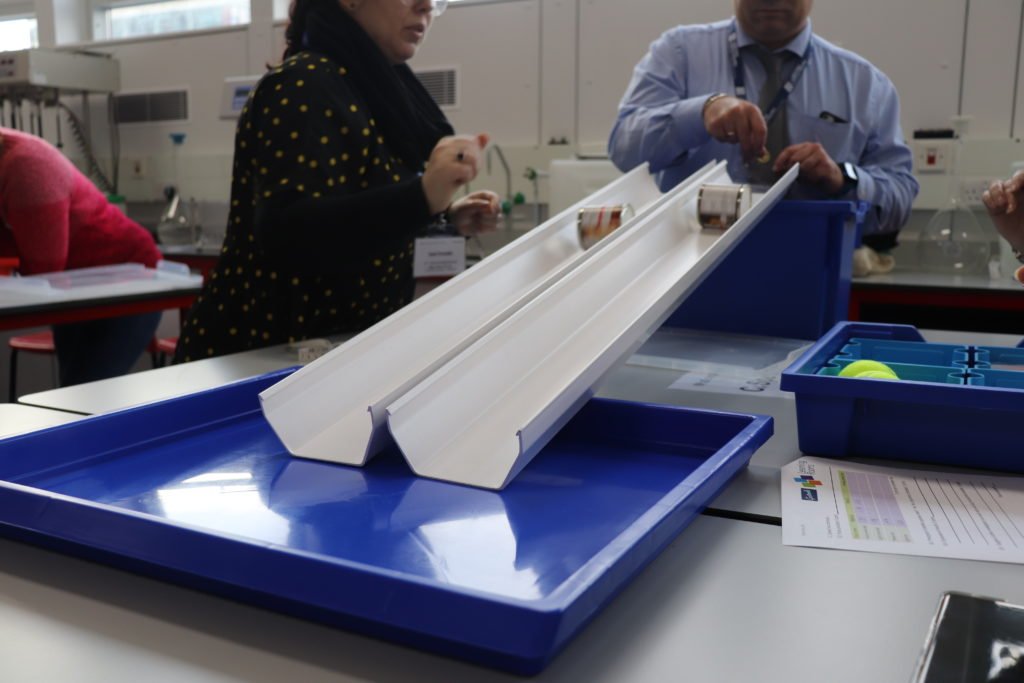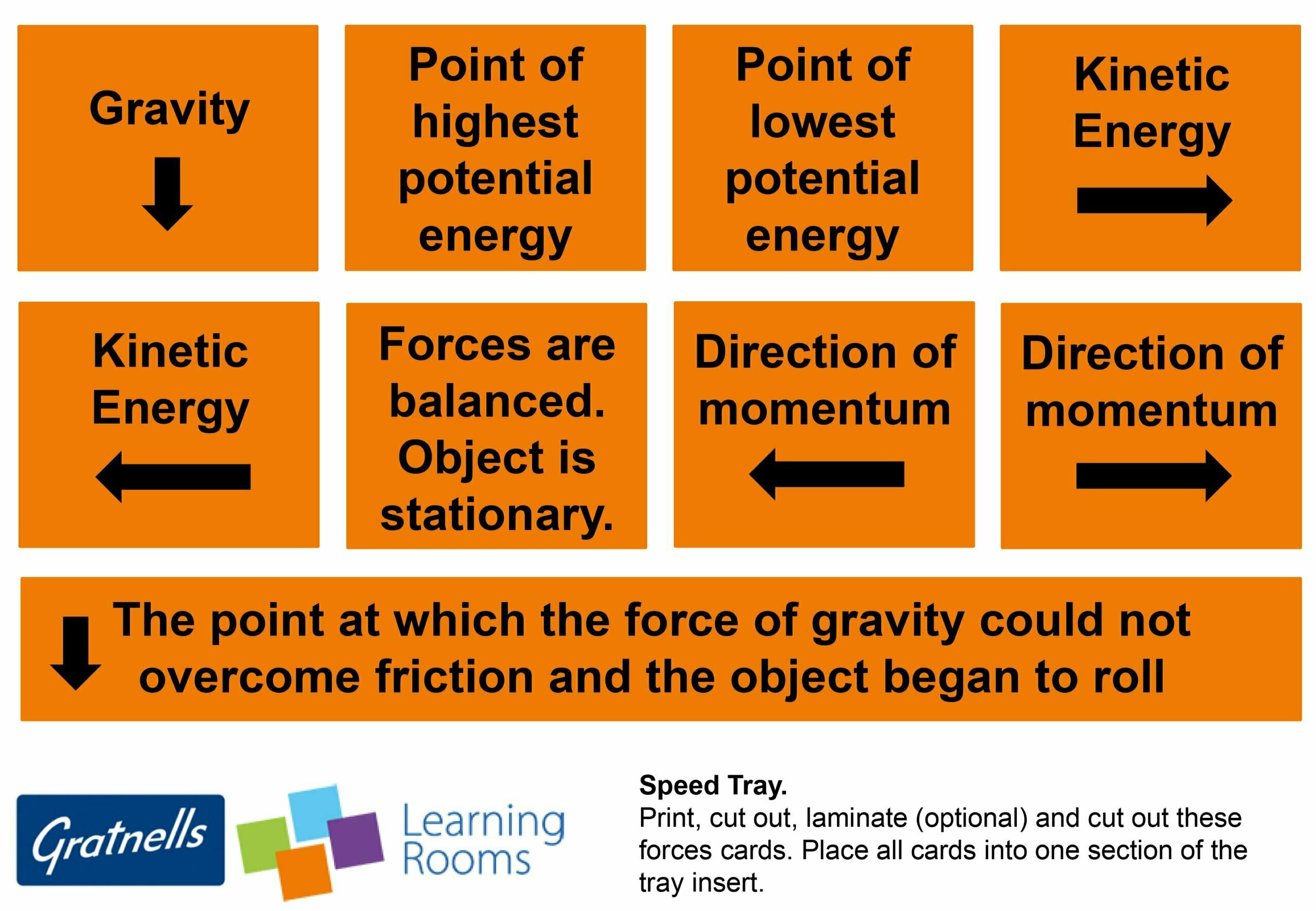Speed tray
This activity was created as part of a Gratnells What’s in my tray? CPD workshop for secondary science teachers and technicians to support practical work and delivery of the curriculum. It can be carried out as a stand-alone activity for students or combined with other activities from the session to form a STEM carousel. If you would like to find out more about running this activity as part of a carousel, take a look at the CPD Workshops section of the Gratnells Learning Room website where you will find further details and example carousels.

Investigate forces and motion by performing your own experiments. Take pictures or video to capture your work
Learning outcomes
You will be able to:
- Work scientifically, including making predictions using scientific knowledge and understanding, making and recording observations and measurements, and using apparatus.
- Describe what is happening in terms of gravity, balanced and unbalanced forces, potential energy, kinetic energy and gravity and use force arrows to label apparatus. .
- Calculate average speed using the quantitative relationship between distance and time, and relate speed to energy and mass.
You will need (per group of 4):
- 1 x Extra deep Gratnells (F25) tray
- 1 x Shallow Gratnells tray with lid
- 1 x Gratnells art tray
- 1 x 4-section Gratnells tray insert or 4 x Blue SortED trays
- 2 x Identical pieces of square guttering 1m long*
- 6 x Small marble sized pieces of blue tack
- 2 x Tennis ball, one filled with water, one unaltered
- 2 x Small tin can*, one full, one empty (can should be less than 7cm tall)
- 1 x Can opener (for preparation use only)
- 1 x Syringe and two needles (for preparation use only)
- 1 x Stopwatch
- 1 x Electronic weighing scale
- 1 x Dressmakers measuring tape
- 1 x Instruction sheet
- 1 x Set of forces cards
- 1 x Question sheet
- Paper and pen, or a tablet with camera for recording your answers.
*Tips: If you don’t have access to square guttering, the channels can be made from folded lengths of cardboard, just make sure your two channels are identical to keep this variable constant. We used Tesco’s small cans of evaporated milk for our cans, any other small liquid filled can would work.
This activity also works for individuals or smaller groups, just increase the amount of time allocated to complete it. Once prepared, this activity can be repeated multiple times, reusing the same equipment for each group.
Preparation:
- Empty one tin can of its contents. To do this, make one small hole in the rim with a can opener, tip out the liquid contents (in to a clean container so it does not have to be wasted) and rinse the can with water. Do not leave any sharp edges or large holes.
- Fill one tennis ball with water using two needles and a syringe. To do this, insert two needles into the syringe about 1cm apart, pump water in to the ball via one of the needles using a syringe, let the air escape out of the other needle. Continue until the ball is completely full. The ball will self-seal once the needles are removed. Many thanks to Helen Rose at the National STEM Learning Centre for sharing this method.
- Print and laminate (optional) one copy of the activity instructions or view on any device.
- Print one copy of the question sheet per group or view and edit on any device.
- Print, cut out and laminate (optional), one set of the forces cards.
- Set up the guttering channels in parallel to run from the extra deep tray into the art tray. Prevent slippage by placing blue tack strips at the contact See the photograph for the equipment set up.

- Put a small ring of blue tack in the middle of the balance plate and put the balance into the extra deep tray. The blue tack ring will enable the tennis balls to be weighed without rolling away.
- Organise the tennis balls, tin cans, stopwatch, forces cards and tape into the 4-section tray insert or blue SortEDs in the shallow tray and put the lid on. Put the instruction and answer sheets on top of the lid.
What to do:
- Lift the lid off the shallow tray and explore the pairs of matching objects in the tray insert.
- What do you notice about the pairs of matching objects? Write your answer down.
- Predict what would happen if you carried out a race between a pair of matching objects using the parallel sloping channels. Which object would hit the back wall of the bottom tray first?
- Perform a few test runs to get used to holding the two matching objects at the top of the channels and releasing them simultaneously. Was your prediction correct?
- Weigh each object using the balance and record their mass in the table.
- Time how long it takes for each object to travel from the top of the channel to the back wall of the bottom tray. Repeat the test three times on each object. Record the times in the table.
- Calculate the average speed of each object. Does the data support your prediction?
- Label the apparatus with the cards provided to illustrate what is happening. Only some of the cards are appropriate. Take a photograph to evidence your work.
- Explain your results using the terms gravity, potential energy and kinetic energy.
- Suggest a further investigation you could carry out using the equipment provided.
Tidy up time:
- Place the test objects, labels, tape and stopwatch back into the 4-section tray insert and replace the lid.
- Put the balance back in to the extra deep tray.
- Leave the channels set up in parallel.
- Replace the instructions and leave everything tidy.
When all participants/teams have completed the activity, swap answers with another group and mark the answers as the activity leader reads them out or hand your answers to the activity leader for marking.
Example blank answer sheet
Answers
Q1. What do you notice about the pairs of matching objects?
They are the same shape and size, but one is heavier than the other / they have a different mass (1 point)
Q2. Race prediction. The heavier object (highest mass) will travel faster and hit the back wall of the bottom tray first. Or any other prediction. (1 point)
Check the completed table. An example is not provided here because the weights and speeds will differ depending on the tennis balls and cans used. Do a test run with your equipment prior to the students taking part so you have a representative data set for your own equipment. (1 point per completed row)
Q3. Photograph of labelled apparatus taken? Yes (1 point)
Q4. Explain your results using the terms gravity, potential energy and kinetic energy (2 points)
The heavier an object is and the higher it is from the ground, the more potential energy it has. Under the force of gravity, potential energy is transferred into kinetic energy. An object with higher mass has more potential energy, this produces more kinetic energy during rolling resulting in a faster speed. (Or any other factually correct answer).
Q5. Suggest a further investigation you could carry out using this equipment (1 point)
Does increasing the potential energy increase the speed? Raise the hight of the slope and repeat the test. (Or any other feasible suggestion).
What is happening?
Key words: Gravity, Potential Energy, Kinetic Energy, Speed.
The equipment set up allows the following ideas in physics to be explored with the students:
- The faster an object is moving, the more energy it possess.
- The effects of balanced and unbalanced forces on the motion of an object.
- The different types of forces which act on an object and how we can influence those forces by altering the equipment set up e.g. changing the surface or angle of the slope.
- That forces have strength and direction.
- Speed and the quantitative relationship between average speed, distance and time.
- The effect of mass on the speed of an object rolling down a slope.
Gravity is the force that ‘pushes’ everything to the ground. Gravity acts on the objects and ‘pushes’ them down from the top of the channel to the bottom when released. Participants observe and record the effect of mass on the speed of an object travelling down a slope of a known length. The heavier an object is and the higher it is from the ground, the more potential energy it has. Height and gravitational potential energy are directly related meaning if one doubles, so does the other. Under the force of gravity, potential energy is converted into kinetic energy. An object with higher mass has more potential energy, this generates more kinetic energy during rolling resulting in a faster speed (higher velocity). The objects stop in the bottom tray because the forces are in balance again, i.e. the force of gravity is equal to the upward force from the earth/tray.
In this activity, the force of gravity acting on the object at the top of the slope can not overcome friction and the object rolls down the slope. Potential energy is converted in to rotational kinetic energy. If the force of gravity could overcome friction, the object would slide down the slope instead of rolling.
What is speed? Speed = Distance ÷ Time and can be calculated from your readings if you know the length of the channel including the distance to the back wall of the shallow tray. Participants should use the measuring tape to measure the distance travelled and use this with their stopwatch data to calculate speed.
What is velocity? Velocity is speed with a direction. The force of gravity acts on the objects travelling down the guttering to create velocity. The velocity generated by the object as it rolls down the slope provides the momentum required to carry the object over the flat surface of the tray until it hits the back wall of the shallow tray and stops. Momentum doubles as velocity doubles.
Other things to try…
- How could you decrease the speed of objects travelling down the slope? Try altering slope angle, slope surface, object shape or surface shape be sure to only change one variable at a time.
- How could you increase the speed of the objects travelling down the slope?
- How could you decrease friction or change the objects used so objects can overcome friction and slide down the slope instead of rolling? Do you see the same results with sliding objects when testing identical objects with a different mass?
- Once you have established a set up that allows the objects to slide. Experiment by using different shaped objects and investigate the effect of streamlining, introducing the concept of air resistance. Be sure to keep all other variables constant.
- Go large! Develop an experimental set up using 4-meter lengths of guttering.
- Research Galileo Galilei and Isaac Newton to find out more about their experiments and how they helped develop the theory of gravitation.
- Share your photographs and videos on social media using #WhatsInMyTray.
Health & Safety
As with all Gratnells Learning Rooms What’s in my tray? activities, you should carry out your own risk assessment prior to undertaking any of the activities or demonstrations. In particular, risks from collisions and needles should be considered.


